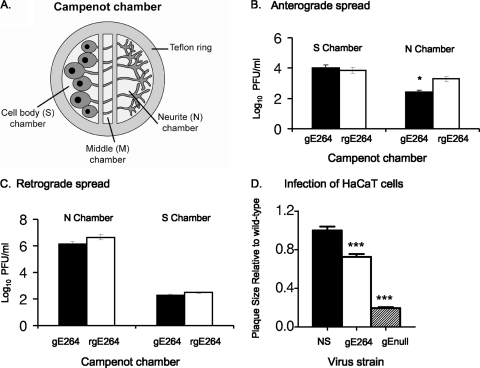FIG. 2.
Spread phenotype of NS-gE264 in vitro. (A) Cartoon of the Campenot chamber system. A Teflon ring is placed on silicon grease within a tissue culture dish to divide the culture into three compartments. SCG neurons are added to the cell body (S) chamber. Neurites (axons) grow through the silicon barrier into the middle (M) and neurite (N) chamber over 2 to 3 weeks. (B) A total of 1 × 105 PFU NS-gE264 or rNS-gE264 was added to S chamber neurons. The titers for the contents of the S and N chambers were determined on Vero cells 48 h postinfection. Results shown are the means ± standard errors of five chambers. *, P < 0.05. (C) HaCaT cells were added to N chamber neurites 1 week prior to infection. A total of 1 × 105 PFU of NS-gE264 or rNS-gE264 was added to the N chamber and overlaid with methylcellulose following infection. The titers of the contents of the N and S chambers were determined on Vero cells 36 h postinfection. Results are the means ± standard errors of six chambers. (D) Plaque sizes of NS and NS-gE264 viruses in HaCaT cells. Results are the means ± standard errors of an experiment that counted 30 to 40 plaques. ***, P < 0.001, comparing NS-gE264 with NS or NS-gEnull. gE-264 is strain NS-gE264; gEnull is strain NS-gEnull.

